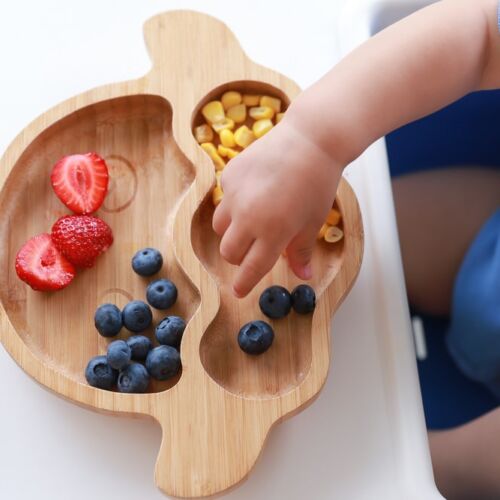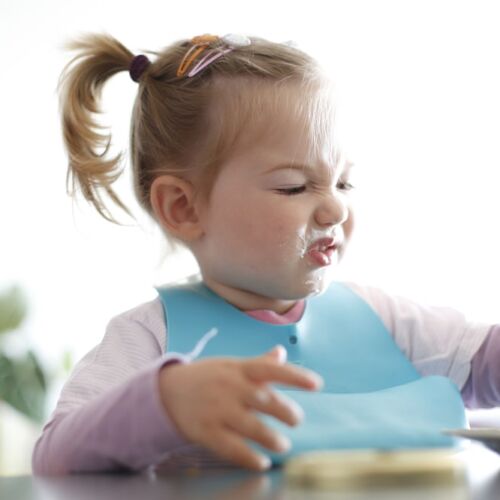Baby Led Weaning vs. Purees
by Beth Ferguson, RD

When it comes to getting ready to feed your baby, there is great debate on which way to do it: baby led weaning vs purees. My goal is to explain each one and why one may be better than the other. Baby led weaning and spoon feeding purees are both methods of weaning. Weaning refers to the introduction of solid foods. It is a gradual change where an infant goes from having only breastmilk or formula to having no breastmilk or formula at all. This change takes at least 6 months to possibly several years (knowing how long the breastfeeding relationship can be).
While the term Baby Led Weaning may sound new and trendy. The actual method of baby led weaning is probably centuries old, starting back as far as humankind. While purees were brought on just 100 years ago in the 1920s as a convenience food.
What is Baby Led Weaning?
Baby led weaning is different from traditional weaning in two major ways. The first is babies are largely offered whole table foods instead of only purees. The second difference is baby’s are allowed to lead the process. The parent sets the food in front of the baby for the baby to pick up themselves and to decide when they are done eating.
Purees
Usually when people use the term purees, they are referring to purchasing baby food from the store and spoon feeding that to the baby. This method is more parent-led than baby-led. There are some nuances with this method, some people make their own homemade baby food or some will also use purees for a few days and ease into baby-led weaning. The latter is not necessary, however, it generally is used for easing the parent’s mind around fears of choking.
Pros of Baby-Led Weaning
There are 3 major concepts that I melt all the pros of Baby-Led Weaning down into.
They are:
- Improved nutrition
- Improved safety
- Improved thriving of the baby
Baby-led weaning for improved nutrition
When babies are fed whole table foods, they are getting the food in its original form, therefore, preserving some of the food’s nutrient quality unlike a more processed food. Additionally, it’s pretty hard to find something like egg, beans or quinoa in a baby food jar. Some companies are becoming quite creative and are making baby meals. Therefore, babies are getting a wider variety of nutrients from offering fresh, whole foods. Babies also consume less heavy metals from eating a wider variety of foods.
Another note on nutrition is that baby-led weaning supports continued breastfeeding really well. When infants start solid foods, the solid foods are meant to complement breastmilk or formula feeds. The goal is NOT to substitute food for milk feeds. Eventually that will happen, however, until 12 months, solid foods are meant to be explorative and complementary.
We do like to choose foods intentionally with nutrients in mind, you can learn five foods to start with baby led weaning here.
In my professional opinion, baby-led weaning improves the whole family’s nutrition because parents are thinking of different vegetables and fruits to offer the baby. It also might help in planning meals out a little better so you always have something that is baby approved.
Baby-led weaning for improved safety
Baby-led weaning teaches babies to manage foods in their mouth before swallowing. With purees, there is not much to manage, you don’t have to make the food smaller before swallowing it. With baby-led weaning, if you are gumming on a steamed green bean, you are going to have to manipulate that food a bit in your mouth before you can swallow it. If you don’t, you’re sure to gag and spit it out. Whilst choking is not normal, gagging is completely normal and actually a protective mechanism to prevent gagging. It tells the baby, oops, that piece of food needs to be smaller before we are going to let you swallow it.
As Fangupo noted in research from 2016, babies are no more likely to choke with baby-led weaning than they are with purees.
Baby-led weaning for thriving
Baby-led weaning teaches important social skills because babies come to the table at the same time as the rest of the family for important role modeling. Being at the family table can help language development as well. They also learn cool science things like when I drop my food, it falls on the floor! Fun stuff.
The fact that a baby is allowed to pick up her food and stop when she is finished is another key that lends to thriving throughout childhood and adulthood. According to Gill Rapley, research suggests that a controlling approach by the parent during feeding trying to finish the bottle or all of the jar is associated with a reduced satiety response. This means babies who turn into kids are less likely to feel their fullness and potentially eat more than what they are hungry for.
Cons for Baby-Led Weaning
Literally the biggest con I have found parents talk about for Baby-Led Weaning is that it tends to be a little messy. However, you can improve that by having the right gear.
Baby-Led Weaning Gear
I usually suggest an easy to wipe highchair with an adjustable footrest so babies feet can always feel secure. Splat mats can be placed under the highchair or if you have a pet, they can double as the vacuum cleaner. For babies, I really love the baprons for bibs. They are lightweight, waterproof and easy to clean.
Another inconvenience instead of maybe a con I’ve heard from parents is baby-led weaning takes some time to plan. They want to have nourishing meals for their baby and the meals they are currently making seem like they aren’t suitable for a baby. Maybe they feel their meals have too much sodium or not enough vegetables. If this is the case and you’re seeking help, this Baby-Led Weaning Course might be the best fit for you. Use code client50 to get $50 off. I have helped parents build meals for their baby and family and also have a free Facebook community where I share tips on starting solids, baby-led weaning and breastfeeding. It’s called Nourishing Babes; Breastfeeding & Baby-Led Weaning Support.
Pros of Purees
- Convenience
Convenience pretty much describes purees. We choose them because it’s what we’ve always known, we don’t have to think about what to give the baby, and we don’t have to worry about gagging or choking (at least now).
Cons of Purees
- Heavy metals
- Reduced nutritional variety
- Teaches baby to swallow instead of chew first
Combined version of Baby-Led Weaning & Purees
I never like things that have to be black and white, therefore, this combined method of Baby-Led Weaning and Purees needs to be discussed. The combined method may be somewhat confusing for babies because sometimes they are being allowed to decide how much they want to eat and other times they are being spoon fed.
While it is not necessary to use both methods, sometimes parents feel better if they start with purees at 6 months and ease into baby-led weaning. This is again not a necessity developmental wise, however, if it makes you more comfortable, I think it’s a great bridge. I give parents the tip to offer purees and use EzTotz or some other spoons to dip into the puree or load the puree on the spoon and then let the baby bring it to their mouth. In this way, you’re still utilizing methods of Baby-Led Weaning.
You can also encourage your daycare to do this as well if they will not let you bring your own food in to give to the baby.
Free Starting Solids Training
I will go into a little bit more detail with all of this plus teach you the different sizes of food (palmar and pincer) and give you a few tips about introducing allergens in my FREE 20 minute starting solids training!
Seek a professional’s help!
I help parents navigate the troubles of starting solids with their babies and accept many insurances. Book an appointment now if you are needing more individualized help.
Beth Ferguson is a registered dietitian located in Niota, Illinois. She provides nutrition counselling on intuitive eating, mindful eating, PCOS, pregnancy & breastfeeding, digestive health, emotional eating, and pediatrics. Beth can be found at https://nourishingbabes.com/ for more information.
Images: From Unsplash and Pexels
The Site is not intended to be a substitute for professional advice. Under no circumstances will we be liable for any loss or damage caused by your reliance on information obtained through the Site. You are responsible for evaluating the accuracy, completeness, or usefulness of any information, opinion, advice, or other content available through the Site. Please seek the advice of professionals, as appropriate, regarding the evaluation of any specific information, opinion, advice, or other content. Never disregard professional advice, including medical advice, or delay in seeking it because of something you have read on this Site.



